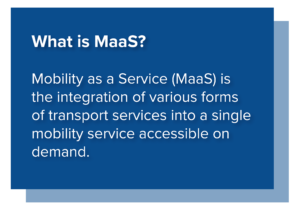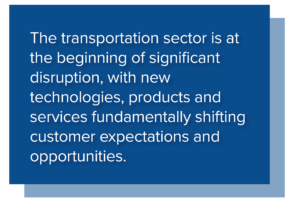Mobility as a Service and the Evolution of Auto Financing to Drive It
Mobility as a Service (MaaS) is the shift away from vehicle ownership toward subscription-based transportation services. In the private sector, automotive dealerships, whether physical or virtual stores, are the centerpiece of mobility services, enabling manufacturers to showcase their products and make them accessible to customers. Transitioning from vehicle ownership to mobility services involves several additional players.
 From the perspective of the customer, they demand an experience that not only meets their mobility needs but also satisfies their interactions with their chosen service providers. Dealers require steady revenue streams. The opportunities for them include mobility services, vehicle sharing, fleet management and vehicle maintenance. Manufacturers enable dealers to meet customers’ needs by creating suitable products. Lastly, auto-financing companies deploy risk-management tactics to reduce the operational costs of managing vehicle fleets. A good example is vehicle analytics. It can automate risk mitigation by tracking vehicles for asset auditing and insurance rating. It can also monitor vehicle usage and condition for asset valuation.
From the perspective of the customer, they demand an experience that not only meets their mobility needs but also satisfies their interactions with their chosen service providers. Dealers require steady revenue streams. The opportunities for them include mobility services, vehicle sharing, fleet management and vehicle maintenance. Manufacturers enable dealers to meet customers’ needs by creating suitable products. Lastly, auto-financing companies deploy risk-management tactics to reduce the operational costs of managing vehicle fleets. A good example is vehicle analytics. It can automate risk mitigation by tracking vehicles for asset auditing and insurance rating. It can also monitor vehicle usage and condition for asset valuation.
Subscription services and the MaaS movement
Several attempts by large and small automotive companies to provide subscription-based vehicle services have failed. Common failure points include the financial sustainability of mobility programs, which are driven by high operating costs that fuel expensive subscription products with low adoption. For a program to be financially sustainable, it must include a steady and reliable revenue stream. It must also operate at a low cost and serve all customers’ mobility needs including ride sharing, vehicle sharing, vehicle rental and vehicle leasing. The perfect formula to achieve financial sustainability has yet to be defined, but key and foundational components have begun to emerge, bringing the industry closer to achieving high-value MaaS.
Lessons learned
MaaS operators must build their business on vehicle fleet management if they want to leverage a motor pool for revenue-generating potential. The best equipped and experienced business for the task are vehicle dealers. Dealers are experienced managers of large inventories of new and used vehicles. They are also experienced in vehicle maintenance supported by vehicle manufacturers, customer service, and vehicle and capital financing. Dealers also have deep partnerships with vehicle manufacturers and finance companies. Here is a breakdown:
Fleet management - Dealers manage large inventories because new-vehicle business depends on purchasing large inventories from manufacturers to maximize profits, while used-vehicle sales bring the highest margins per unit. Finding non-traditional ways to maximize the use of their inventory in a fleet model will further increase revenues.
Shift to new products - Dealers have traditionally had sporadic interactions with customers. Beyond the initial sale of a vehicle and subsequent servicing interactions, the dealer-customer relationship is limited and not constant. Auto financing companies have more frequent interactions with customers because they manage and nurture customer relationships after the vehicle purchase. Dealers and financiers have an opportunity to create frequent and high-touch interactions with customers by offering high-value mobility services supported by their large fleet of vehicles and already-established service departments.
Maximize profits - Dealers have the expertise and resources to maintain and repair vehicles for safe operation. Multi-make dealers are best positioned to maintain cross-brand vehicle fleets as these dealers have established relationships with multiple manufacturers and can provide variety for customers at a lower cost. New vehicle maintenance provides the highest margins as manufacturers cover most expenses under new vehicle warranties.
Reduce cost and risk - Fleet-management techniques based on data analytics from connected vehicles, service networks and customer insights provide an operating model that maximizes cost efficiencies for the operator and value for the customer.
 The leading opportunity to kick-start the private segment of MaaS is with the demands of gig workers in the areas of ride sharing (Uber, Lyft, etc.) and delivery services (DoorDash, Amazon, etc.). Access to affordable and reliable mobility services by gig workers enables their independent businesses. As the segment matures, other MaaS product offerings can more easily be added to expand and capture new customers in areas such private mobility (short and long-term subscriptions) and commercial trucking (in-town and interstate).
The leading opportunity to kick-start the private segment of MaaS is with the demands of gig workers in the areas of ride sharing (Uber, Lyft, etc.) and delivery services (DoorDash, Amazon, etc.). Access to affordable and reliable mobility services by gig workers enables their independent businesses. As the segment matures, other MaaS product offerings can more easily be added to expand and capture new customers in areas such private mobility (short and long-term subscriptions) and commercial trucking (in-town and interstate).
The tools required to enable these services remain similar to traditional auto-finance value chain processes including product development, sales and marketing, origination, servicing, collections, and recovery and asset monitoring. The opportunities are centered on how the tools are leveraged and deployed in order to create new products or expand existing infrastructures to support the MaaS platform.
Mobility as a Service is more than the digitization of acquiring transportation. It’s a confluence of transportation, technology and user adoption, creating a seamless on-demand service that’s set to change the way people live. As the future of mobility accelerates, organizations need to move at top speed to get on board.
Article by Arturo Sanabria, Vice President of Consulting Services at Avaap. Avaap is a technology management and consulting services firm with nearly 20 years of experience in financial technology and expertise in using business intelligence and analytics to drive process efficiencies and KPIs.

